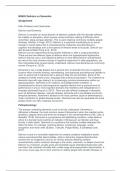NR603 Delirium vs Dementia
Assignment
Hello Professor and Classmates,
Delirium and Dementia
Delirium is consider an acute disorder of attention, patients with this disorder willhave
the inability or disruption, which causes mental confusion making it difficultto think,
remember, sleep and pay attention. This is seen relatively commonly inelderly people
(Kukreja, Günther, & Popp, 2015). Delirium is a syndrome manifesting as an acute
change in mental status that is characterized by inattention and disturbance in
cognition that develops over a short period of timeand tends to fluctuate. Delirium can
also be preventable (Fong et al., 2015).
Delirium can be experienced during alcohol withdraw or after a surgical procedure.
There are also two different types of delirium which are hypoactiveand hyperactive
delirium that can occur, but hypoactive delirium is more likely.Delirium and dementia
are two of the most common causes of cognitive impairment in older populations, yet
their interrelationship remains poorly understood. Delirium and dementia can commonly
coexist (Fong et al., 2015).
Dementia is not a single disease but a general term to describe the loss of cognitive
function which involves thinking, remembering, and reasoning and behavioral abilities to
such an extent that it interferes with a person's daily life and activities. Some of the
symptoms include memory loss, language skills andvisual perception. The incidence of
dementia rises with age making it an increasingly common phenomenon within our
aging population. Dementia is an insidious neurodegenerative condition, is
characterized by chronic and progressive cognitive decline from a previous level of
performance in one or more cognitive domains that interferes with independence in
everyday activities(Fong et al, 2015). There are also different subtypes of dementia
such as Alzheimer disease, vascular disease, dementia with Lewy Bodies and fronto-
temporal dementia. Alzheimer's disease is the most common cause of dementiaand a
major contributor for global disease burden. Dementia can also be separated into three
phases which are mild, moderate and severe.
Pathophysiology:
The process underlying dementia is yet to be fully understood. Dementia or
Alzheimer’s disease, the most common cause of dementia is when the cerebral cortex
atrophies, plaques forms and there are changes in the neurotransmitters (Falk, Cole, &
Meredith, 2018). Dementia is a progressive and debilitating condition, unlike delirium
where it is transient and could be an indicator of illnesssuch as infection and drug
toxicity in older adults. Dementia is a syndrome that includes multiple diseases that
affect the brain, for example, cognitive decline, functioning, language, social
recognition and motor skills (Buttaro, Trybulski, Polgar-Bailey, & Sandberg-Cook,
2017).
Delirium is due to a reversible impairment of cerebral oxidative metabolism and/or
various neurotransmitter abnormalities, while in dementia, impaired brainfunction
results from an exogenous insult or an intrinsic process affecting cerebral
neurochemistry and/or anatomic damage to the cortex, subcortex, or deeper structures.
Delirium is a transient, usually acute and reversible cause ofcerebral dysfunction with
confusion that manifests clinically with a wide range ofneuropsychiatric abnormalities. It
can occur at any age, but is more common in elderly people with somatic illnesses or




